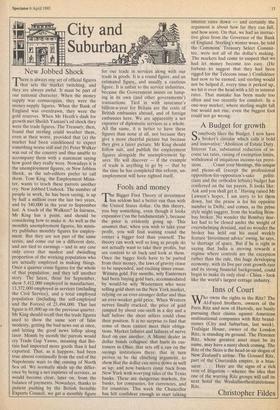City and
New Jobbed Shock
rr here is always one set of official figures that sets the market twitching, and they are always awful. It must be part of our national character. When the money supply was cornucopian, they were the money-supply figures. When the Bank of England was overdrawn, they were the gold reserves. When Mr Heath's dash for growth met Sheikh Yamani's oil shock they were the trade figures. The Treasury, then, found that sterling could weather them, even at their worst, provided that (a) the market had been conditioned to expect something worse still and (b) Peter Walker was out of the country and thus unable to accompany them with a statement saying how good they really were. Nowadays it is the unemployment figures, or New Jobless Shock, as the sub-editors prefer to call them. Tom King, the Employment Minis- ter, wants to teach these parrots another cry: New Jobbed Unshock. The number of people in work, he has been saying, is up by half a million over the last two years, and by 340,000 in the year to September last. A touch of the Walkers? In fairness, Mr King has a point, and should be considering how to make it. As well as the monthly unemployment figures, his minis- try publishes monthly figures for employ- ment. But they are not part of the same series, and come out on a different date, and are tied to earnings – and in any case only cover that modest and dwindling proportion of the working population who are actually employed in making things. Once a quarter come figures for the whole of that population, and they tell another story. The latest, those for September, show 5,412,000 employed in manufacture, 13,372,000 employed in services (including the Civil Service), and a total employed population (including the self-employed and the Forces) of 23,494,000. That last figure is 65,000 up on the previous quarter. Mr King should recall that the trade figures used to show the same sort of false modesty, getting the bad news out at once, and letting the good news lollop along later. Month by month the parrots would cry Trade Gap Yawns, meaning that Bri- tain had imported more goods than it had exported. That, as it happens, had been true almost continually from the end of the Napoleonic wars to the coming of North Sea oil. We normally made up the differ- ence by being a net exporter of services, as would become clear, later on, from the balance of payments. Nowadays, thanks to patient pushing by the British Invisible Exports Council, we get a monthly figure for our trade in services along with our trade in goods. It is a round figure, and an estimated figure, and usually a cautious figure. It is unfair to the service industries, because the Government insists on lump- ing in its own (and other governments') transactions. Tied in with insurance's billion-a-year for Britain are the costs of British embassies abroad, and of foreign embassies here. We are apparently a net exporter of diplomatic services as a whole. All the same, it is better to have these figures than none at all, not because they give a more cheerful picture but because they give a fairer picture. Mr King should follow suit, and publish the employment figures alongside the unemployment fig- ures. He will discover — if the example of trade is anything to go by — that by the time he has completed this reform, un- employment will have righted itself.










































 Previous page
Previous page